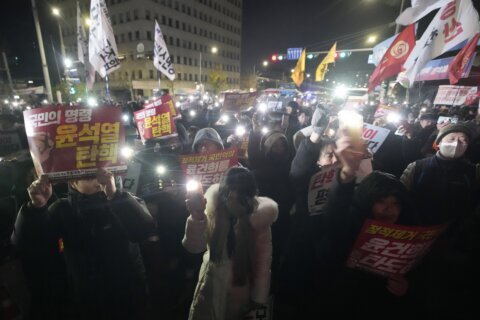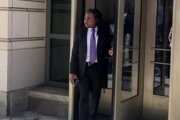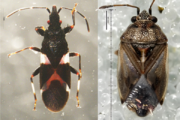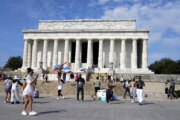TOKYO (AP) — The recipient of this year’s Nobel Peace Prize is a fast-dwindling group of atomic bomb survivors who are facing down the shrinking time they have left to convey the firsthand horror they witnessed 79 years ago.
Nihon Hidankyo, the Japanese organization of survivors of the U.S. atomic bombings on Hiroshima and Nagasaki, was awarded for its decadeslong activism against nuclear weapons. The survivors, known as hibakusha, see the prize and the international attention as their last chance to get their message out to younger generations.
Terumi Tanaka, 91 and who survived the Nagasaki bombing at age 13, said he hopes the award will help raise public awareness about the need to join hands to achieve a world without nuclear weapons. He said he he feels the hibakusha’s desperate wish is not fully understood even as their population rapidly declines.
“Now we face the crisis in which nuclear weapons may be actually used and they are not even going away, we need to properly communicate with younger people and teach them about atomic weapons and the work we have been doing … so everyone can think what he or she can do,” Tanaka told a news conference in Tokyo with several other survivors.
“We’ve led the activism because we were atomic bombing victims, but I must say all of you are the future hibakusha candidates. So you should fully understand what it means to be hibakusha” and work together, Tanaka said.
The honor rewards members’ grassroots efforts to keep telling their stories — even though that involved recollecting horrendous ordeals during and after the bombings, and facing discrimination and worries about their health from the lasting radiation impact — for the sole purpose of never again let that happen.
Now, with their average age at 85.6, the hibakusha are increasingly frustrated that their fear of a growing nuclear threat and push to eliminate nuclear weapons are not fully understood by younger generations.
The number of prefectural hibakusha groups decreased from 47 to 36, according to Hidankyo. And the Japanese government, under the U.S. nuclear umbrella for protection, has refused to sign the Treaty on the Prohibition of Nuclear Weapon.
Japan’s new Prime Minister Shigeru Ishiba, at a party leaders’ debate in Tokyo Friday, said that while Japan needs to keep conveying the tragedy of nuclear weapons to the world, in reality it is crucial to balance nuclear deterrence and the need to achieve a nuclear-free world.
Tanaka rejected Ishiba’s justification for nuclear weapons for deterrence and his idea of sharing the U.S. nuclear capability in the region as “out of the question.” Tanaka, who briefly talked with Ishiba who called to congratulate him earlier Saturday, said he hoped to meet the prime minister for fuller talks.
Another Hidankyo executive, Jiro Hamasumi, who survived the Hiroshima bombing inside of his mother’s womb, said the group has faced declining hibakusha membership and financial difficulty, and is seeking to involve younger supporters and second-generation hibakusha to keep their activity going.
But there is hope, and a youth movement seems to be starting, the Nobel committee noted.
Three high school students accompanied Mimaki at the city hall, stood by him as the prize winner was announced, and promised to keep their activism alive.
“I had goose bumps when I heard the announcement,” said a beaming Wakana Tsukuda. “I have felt discouraged by negative views about nuclear disarmament, but the Nobel Peace Prize made me renew my commitment to work toward abolishing nuclear weapons.”
Another high school student, Natsuki Kai, said, “I will keep up my effort so we can believe that nuclear disarmament is not a dream but a reality.”
In Nagasaki, a group of students celebrated Hidankyo’s win. Yuka Ohara, 17, thanked the survivors’ yearslong effort despite the difficulty. Ohara said she heard her grandparents, who survived the Nagasaki bombing, repeatedly tell her the importance of peace in daily life. “I want to learn more as I continue my activism.”
In April, a group of people set up a network, Japan Campaign to Abolish Nuclear Weapons, connecting younger generations around the country to work with survivors and pursue their effort.
Efforts to document the survivors’ stories and voices have grown in recent years around Japan, including in Hiroshima, Nagasaki and Tokyo. In some places, young volunteers are working with hibakusha to succeed their personal story telling when they are gone.
The first U.S. atomic bombing killed 140,000 people in the city of Hiroshima. A second atomic attack on Nagasaki on Aug. 9, 1945, killed another 70,000. Japan surrendered on Aug. 15, bringing an end to its nearly half-century aggression in Asia.
Hidankyo was formed 11 years later in 1956. There was a growing anti-nuclear movement in Japan in response to U.S. hydrogen bomb tests in the Pacific that led to a series of radiation exposures by Japanese boats, adding to demands for government support for health problems.
As of March, 106,823 survivors — 6,824 fewer than a year ago, and nearly one-quarter of the total in the 1980s — were certified as eligible for government medical support, according to the Health and Welfare Ministry. Many others, including those who say they were victims of the radioactive “black rain” that fell outside the initially designated areas of Hiroshima and Nagasaki, are still without support.
Copyright © 2024 The Associated Press. All rights reserved. This material may not be published, broadcast, written or redistributed.





